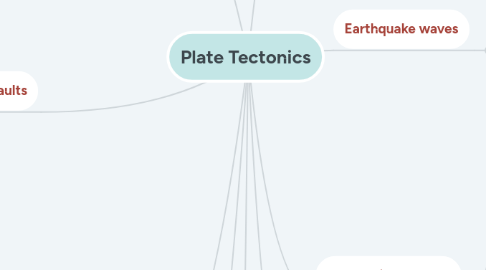
1. Layers of Earth
1.1. Crust
1.2. Mantle
1.3. Inner core
1.4. Outer core
2. Faults
2.1. What is a fault
2.1.1. A fault is a fracture along which the blocks of crust on either side have moved relative to one another parallel to the fracture. Strike-slip, normal, and reverse faults. A reverse fault with a small dip angle is called a thrust fault.
2.2. Types of Fault
2.2.1. Normal Fault
2.2.1.1. a dip-slip fault in which the block above the fault has moved downward relative to the block below. This type of faulting occurs in response to extension and is often observed in the Western United States Basin and Range Province and along oceanic ridge systems.
2.2.2. Reverse Fault
2.2.2.1. A transform fault or transform boundary is a fault along a plate boundary where the motion is predominantly horizontal. It ends abruptly where it connects to another plate boundary, either another transform, a spreading ridge, or a subduction zone
2.2.3. Transform Fault
2.2.3.1. Reverse faults are exactly the opposite of normal faults. If the hanging wall rises relative to the footwall, you have a reverse fault. Reverse faults occur in areas undergoing compression (squishing)
3. Mid- Ocean Ridges
3.1. Sea-floor spreading
3.1.1. the formation of new areas of oceanic crust, which occurs through the upwelling of magma at midocean ridges and its subsequent outward movement on either side.
4. Plate Boundaries
4.1. Divergent
4.1.1. Two plate moving apart
4.1.2. Mid- Atlantic ridge
4.1.3. Causes
4.1.3.1. Earthquakes
4.1.3.2. Volcanos
4.1.3.3. Rift valley is formed
4.2. Convergent
4.2.1. Two plates are colliding together
4.2.2. Causes
4.2.2.1. Fold mountains
4.2.2.2. Earthquakes
4.3. Subducting
4.3.1. When two plates move towards each other and meet, the heavier oceanic crust sinks below the continental forming a trench
4.3.2. Causes
4.3.2.1. Earthquakes
4.3.2.2. Volcanos
4.3.2.3. Trench
4.3.2.4. Island Arc
4.3.2.4.1. An island arc is a chain of volcanoes which alignment is arc-shaped, and are parallel and close to a boundary between two converging tectonic plates
5. Pangea
5.1. Pangaea or Pangea was a supercontinent that existed during the late Paleozoic and early Mesozoic eras. It assembled from earlier continental units approximately 335 million years ago, and it began to break apart about 175 million years ago.
5.1.1. Fossils on different continents are similar to fossils on continents that were once connected. When the continents split, different life forms developed.
5.1.2. Most continental and oceanic floor features are the result of geological activity and earthquakes along plate boundaries. The exact patterns depend on whether the plates are converging (being pushed together) to create mountains or deep ocean trenches, (diverging) being pulled apart to form new ocean floor at mid-ocean ridges, or sliding past each other along surface faults.
5.1.3. Most distributions of rocks within Earth's crust, including minerals, fossil fuels, and energy resources, are a direct result of the history of plate motions and collisions and the corresponding changes in the configurations of the continents and ocean basins
6. Earthquakes
6.1. causes
6.1.1. volcano
6.1.2. landslides
6.1.3. mining blasting
6.1.4. nuclear testing
6.2. a sudden and violent shaking of the ground, sometimes causing great destruction, as a result of movements within the earth's crust or volcanic action
6.3. measuring quakes
6.3.1. moment magnitude scale
6.3.1.1. measures the amount of energy released in a earthquake
6.3.2. mercalli scale
6.3.2.1. used for measuring an earthquakes intensity, on scale of 1-12
6.4. epicenter
6.4.1. the point on the Earth's surface directly above the focus, the point where the earthquake originates
7. Earthquake waves
7.1. Primary (P) Wave
7.1.1. seismic body wave that shakes the ground back and forth in the same direction and the opposite direction as the direction the wave is moving
7.1.2. can travel through solid and liquid
7.2. Secondary (S) Wave
7.2.1. seismic body wave that shakes the ground back and forth perpendicular to the direction the wave is moving.
7.3. Surface Love (L) Wave
7.3.1. most destructive wave because its surface moves like waves
7.3.2. most destructive wave because its surface moves like waves
8. Convection Current
8.1. Continents move because of convection currents in the earth's mantle
8.2. Found in the asthenosphere
8.3. Upwelling causes plate to move apart
8.3.1. Divergent plate boundary
8.4. Sinking causes plate to pull together
8.4.1. Convergent plate boundary
9. Plate Movement
9.1. plate movement causes
9.1.1. Folding
9.1.1.1. Process that bends and twist rocks due to compression or squezzing
9.1.2. Faulting
9.1.2.1. Process where rocks move past each other along a fracture or crack, occurs where plates are separating, sliding past, or coming together
9.1.3. Vulcanism
9.1.3.1. The movement of molten rocks or magma, beneath or above the earths surface
